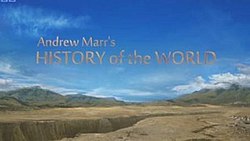Andrew Marr's History of the World
| Andrew Marr's History of the World | |
|---|---|
 |
|
| Genre | Documentary |
| Written by | Andrew Marr |
| Directed by | Neil Rawles (1,2) Renny Bartlett (3,4,5) Mark Radice (4) Robin Dashwood (6,7) Guy Smith (8) |
| Presented by | Andrew Marr |
| Composer(s) | Robert and Peter Hartshorne |
| Country of origin | United Kingdom |
| Original language(s) | English |
| No. of episodes | 8 |
| Production | |
| Executive producer(s) | Chris Granlund |
| Producer(s) | Kathryn Taylor (series) Neil Rawles (1,2) Renny Bartlett (3,4,5) Mark Radice (4) Robin Dashwood (6,7) Guy Smith (8) |
| Production company(s) | BBC/Discovery Channel/Open University Co-Production |
| Release | |
| Picture format | PAL (576i) |
| Original release | 23 September – 11 November 2012 |
| Chronology | |
| Preceded by | Andrew Marr's The Making of Modern Britain |
| External links | |
| BBC website | |
Andrew Marr's History of the World is a 2012 BBC documentary television series presented by Andrew Marr that covers 70,000 years of world history from the beginning of human civilisation, as African nomadic peoples spread out around the world and settled down to become the first farmers, up to the twentieth century.
The series is noted for its elaborate, Hollywood-like recreations of many of the people and events on which Marr frames his story. Great care was taken in accurate costumes and the use of the original language of those portrayed. To this are added elaborate digital effects, such as a recreation of the Palace of Knossos or the diversionary channels dug to control flooding of the Yellow River.
Producer Robin Dashwood on the BBC website provides background to how the series was made, beginning with financial limitations on travel which set them seeking one location "which would furnish us the whole world":
We found the answer in Cape Town, South Africa. Not only does it have a highly-skilled film infrastructure in place, they have a plethora of fantastic locations, all within close proximity of the city centre.
When the three directors and the series producer arrived, we were astonished by what we found. With some skillful set dressing, Cape Town’s Cathedral became Notre Dame and Wittenberg Cathedrals, while a car park in front of the Town Hall became revolutionary Paris; stunning beaches stood in for Australia and the Caribbean; sand dunes became the Middle East; and forests became, well, forests from every continent. Most surprisingly, a young offenders’ institution became a 19th century Chinese street, complete with circling baboons.
Dashwood also notes the diversity of actors available: "Luckily Cape Town is a bit of a melting pot: African, Chinese, European, Middle Eastern you name it, they’ve got it [except Aborigines]." Though crowds are often shown, this was done with the help of computers: "Budgetary considerations meant we had to make a limited number of performers seem like many more - a crowd of 15 often had to stand in for a crowd of 1500. The magic of computer graphics often filled in the missing 1485 – but it was always a challenge."
...
Wikipedia
